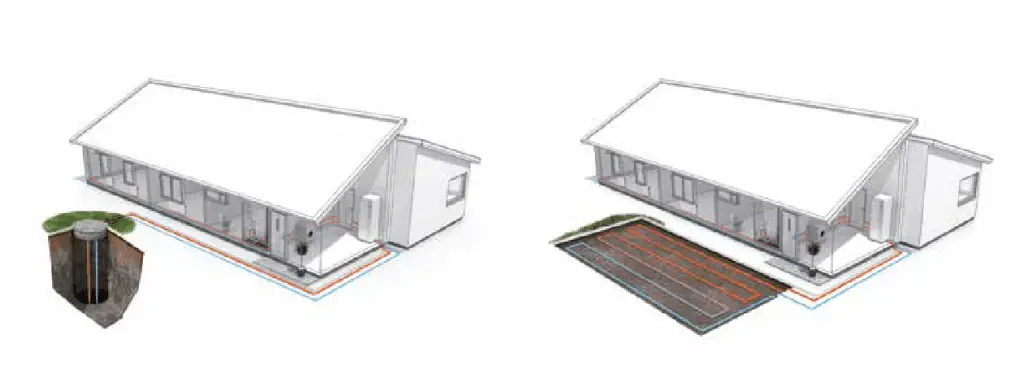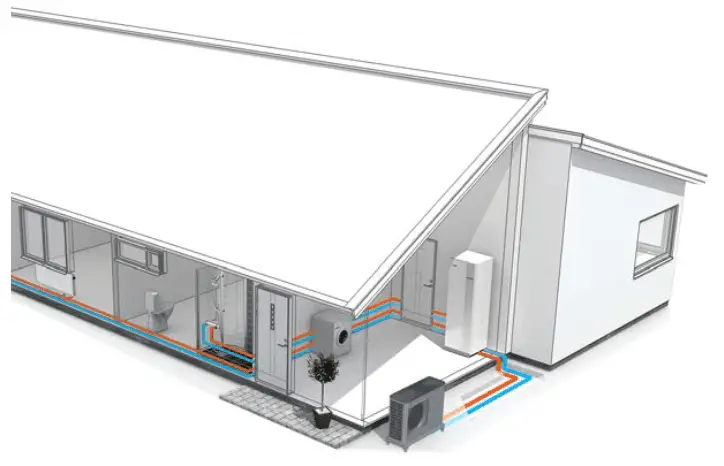I’m in the process of selecting a heat pump for my house and I did a lot of research into the topic. In this article, I will walk you through the considerations when choosing a heat pump type for your house.
The difference between the two types of heat pumps is where they get the energy from. Air source heat pumps (ASHP) absorb heat from the air and ground source heat pumps (GSHP) absorb heat from the ground. The air source heat pumps which we are looking into are air to water heat pumps which transfer heat from the outside air to water, which is used to heat your underfloor heating or radiators. With the ground source heat pumps, the idea is the same so the heat from the ground is transferred into the water.
The idea with heat pumps is to transfer more heat energy into the water than the electric energy used for transferring it.
Potential savings and investment cost of heat pumps
Ground source heat pumps can for some houses save on average 60-80% in annual heating costs. Air source heat pumps have the potential of saving 50-60% in annual heating costs. This however doesn’t automatically make the ground source heat pump the better choice because the investment cost of a ground source heat pump is also higher.
The cost for an air source heat pump installation in Scandinavia can range from around 8000€ to 15000€ in an average size house. Ground source heat pump installations cost around 15000€ to 25000€ in average size houses.
The consumer’s investment cost can be reduced via government incentives by around 2000-6000€.

Requirements for installing a heat pump
Air to water and ground source heat pumps are best suited for houses that have either underfloor heating or hot water radiators. In these houses, the existing heating system is usually either an oil heating system or an electrical heating system.
For the investment to make sense the energy demand needs to be high enough for the investment to make sense.
Ground source heat pumps have additional requirements since a ground-loop needs to be installed either vertically by drilling a hole in the ground or horizontally burying pipes over a wide area of ground. In some countries, the vertical ground loop requires drilling permissions which may not be granted in all places and the horizontal option requires a substantial amount of open ground.

Criteria for choosing a ground source heat pump over an air source heat pump
You can also listen to my video below if you prefer that over reading about the criteria.
Criteria 1. House size
The bigger the house, the higher the energy demand, and the more likely it is to make a ground source heat pump a more economical purchase than an air source heat pump.
It should be noted that the choice of the heat pump should not be based solely on the heated square footage of the house. Heating costs are affected by many factors other than the area of the house alone. Such factors are:
- geographical location of the house
- year of construction
- building material
- heat distribution (radiators or underfloor heating)
- subsequent actions to improve the insulation of the house
- individual needs in the amount of hot water and indoor temperature
Be sure to also consider any future added living space or connecting cold rooms to the heating circuit. However, the size of the house can be used as a proxy to get a rough idea.
Criteria 2. House age and insulation
The older the house and the worse the insulation of the house, the higher the energy requirements of the house and the more likely it is to make a ground source heat pump a more economical purchase than an air source heat pump.
The older the house is the worse the insulation often is and this can lead to very large differences in heating costs for two houses of the same size. And the higher the heating cost of the house, the greater the benefit of a ground source heat pump.
When the heating energy demand of a 150m2 house which was recently built is about 17,000 kWh annually, the heating energy demand of a very old log house in the same location can be doubled, about 33,000 kWh. We cannot justify the choice of a ground source heat pump solely on the heated square footage of a house. The year of construction and the building material play a very important role in the energy demand.
Criteria 3. House location
The farther north the house is, the better the ground source heat pump is compared to an air source heat pump. The economic benefits of an air source heat pump are all the more evident the further south the house is.
In addition to the insulation of the house, the location of the house must be taken into account. A certain outdoor temperature is defined at which the peak power demand of a new house to be built is calculated. Because geographic location particularly affects the efficiency of an air-source heat pump, ground source heat may become a more sensible choice due to the geographic location of the house.
The temperature of the fluid circulating in the ground source energy well does not change much with the seasons, while the air temperature has a large effect on an air source heat pump’s efficiency. On the other hand, the equation also works the other way around. As the outside air heats up to well above zero, the efficiency of an air-to-water heat pump begins to be better than that of a ground source heat pump.
Criteria 4. Required water temperature
A ground source heat pump is capable of producing very hot water temperatures regardless of the outdoor temperature. If your house has an old radiator network that requires high water temperature, a ground source heat pump is a better option.
Water circulating radiator systems and underfloor heating are the most common heat distribution methods for heat pumps.
The advantage of underfloor heating compared to the radiator network is that it can heat the house with less hot water. The lower the flow temperature, the better the efficiency of the ground source heat pump. With single-leaf old radiators, the water needs to be considerably hotter than with underfloor heating. Modern ground source heat pumps are capable of producing a flow temperature of up to 68 degrees Celcius, so the area of the radiator network is very rarely too small and there is rarely a need to renovate the radiator network. In an average detached house, the savings advantage for underfloor heating over the radiator network is about 100 euros per year.
With an air-to-water heat pump, the ability to produce hot flow temperatures decreases as the outside temperature decreases. So this is exactly when the hotter flow temperatures would be required to heat the house.
Criteria 5. Incentives can turn the advantage
The final cost of the ground source heat pump system at the renovation site is considerably lower than the heat pump supplier’s offer suggests. In many countries, there are incentives in the form of grants or tax credits. Since the investment for a ground source heat pump is larger than for an air source heat pump it can in some cases receive a larger incentive narrowing the cost difference of the consumer’s investment.
Criteria 6. House value increased due to central heating investment
If you want to influence the value of your house and speed up its sale time, a ground source heat pump is the best option. At least in Scandinavia, this seems to be the case.
Ground source energy is considered to be the most desired and highest quality heating system. It has the effect of speeding up the selling time of the house and improving the selling price. Real estate agents always make a strong point in their sales announcements if the house is equipped with a ground source heat pump.


